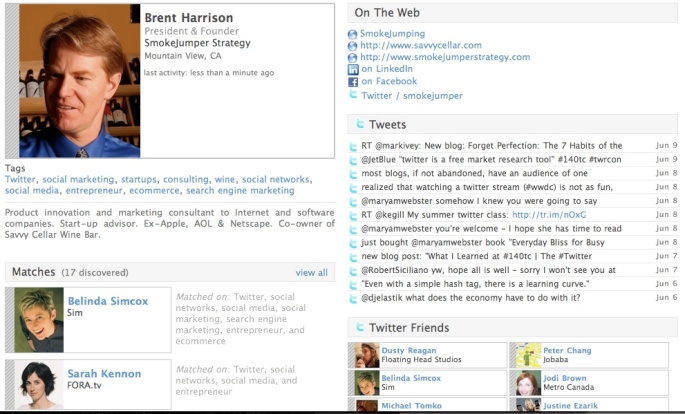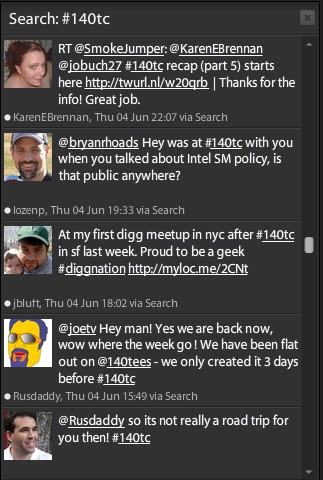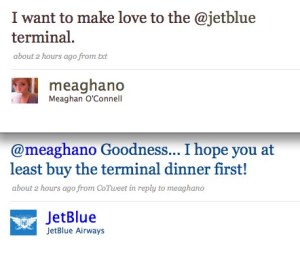Hi all I’ve transfered my blog over to http://www.smokejumperstrategy.com/
March 8, 2011
June 25, 2009
Dude, Where My SEO At?
View this blog post “Dude, Where My SEO At?” on my new blog site at SmokeJumperStrategy.com/blog.
Chicken Little
Recently I was engaged by a security software company to assess their rankings in search engine results. As their newly appointed SEO consultant, the results were not good. Search Engine Optimization (SEO) clearly had not been core to their online marketing practices:
- No knowledge of keyword search market. Without understanding the volume and competitive dynamics for search keywords, identifying the most appropriate search keywords is impossible.
- Low organic search rankings. Due to the lack of focus, the firm had low search engine ranking on many highly relevant search keywords.
- Poor execution. The website was sub-optimal from a search engine optimization perspective – lack of keyword density; non-unique page titles; missing page descriptions; inconsistent utilization of H1 | H2 tags: and no quality link building.
After analyzing the market for search keywords, assessing the competition and baselining the site’s current search engine rankings, this SEO consultant established a list of 25 target search keywords (with a broader list of 75 keywords that could be drawn from).
From there, we focused on all “top-of-funnel”, information and product pages (100+) in their two largest geographical markets. For each of these webpages, we crafted specific SEO recommendations designed to improve search engine ranking. (Due to client direction, we opted to leave page copy and link-building alone for the time being).
Several months passed and we re-assessed the client’s site. Bad news – the search engine ranking hadn’t moved much. Before they fired their SEO consultant, I asked the question: “Dude, Where My SEO At?”
Well, as the dutiful (and, for now, still employed) SEO consultant, I came up with the following five factors that were holding back their search engine rankings and overall search engine optimization:
- Changes to website. The company had made some structural changes to their site hierarchy. Previously URL’s were structured “country.company/com”. Now, the URL’s were reading “home.company.com/country”. Over time this will help expose the whole site to search engine ranking / indexing = goodness. In the short-run, however, the search engines hate this kind of change = badness.
- Implementation lagging. Despite the passage of time, few of the recommended SEO changes on the 100+ pages have been implemented. Technology, internal process and competition for scarce development talent were to blame.
- Search keyword densities – page copy. Web pages were not drafted with search engine keywords in mind. As a result, there is much opportunity to redraft pages with targeted, SEO-friendly copy.
- Links. The quality of links to a particular web page help establish its relevancy and authority for the search engines. Example: for one of the highly desirable SEO keywords, the number of external site links pointing to the company’s web page was eight (8). For the same search keyword, the number links pointing to Competitor A was 182 and Competitor B 2,550.
- Competition. Lastly, the search market is dynamic and increasingly competitive. While the client has stood relatively still and, in the case of site structural changes, actually moved backwards in the eyes of the search engines, it is safe to assume that for highly searched keywords, that competitors are putting forward a concerted effort at improving their own organic search engine rankings.
While the picture for Chicken Little and the client may appear bleak, there are several things that can be done immediately to help reverse the trend and put them on a path to SEO bliss (whether this SEO consultant is involved or not).
- Accelerate implementation of SEO changes (already recommended). If this is not possible given existing constraints, then consider outside resources or focus on the select pages that will have the highest impact on the business.
- Increase search keyword densities. Implementing the keyword changes already recommended will be a great first step. In addition, I recommend to rewrite copy on the handful of pages that will have the highest impact on the economics of the business.
- Increase quality links. A focused effort at increasingly high quality links to select pages will also help drive relevancy, authority (PageRank) and overall search engine ranking.
I’m SEO’d out . . . more later
June 16, 2009
What I Learned at 140 | The Twitter Conference (round-up)
 Well its been a couple of weeks since the 140 | The Twitter Conference ended. The Twitter Conference (#twrcon) has come and gone. A NYC Twitter conference – 140 Character Conference – is now on (#140conf). And I completed my 8-part round-up of my learnings from my experience at #140tc.
Well its been a couple of weeks since the 140 | The Twitter Conference ended. The Twitter Conference (#twrcon) has come and gone. A NYC Twitter conference – 140 Character Conference – is now on (#140conf). And I completed my 8-part round-up of my learnings from my experience at #140tc.
- The Power of Presence. Insights from Alex Payne, Twitter API Lead.
- I am a Twitter God(ess) and So Can You! The View From Twitter Stardom with @ijustine, @missrogue and @davepeck.
- Don’t Take the Drive to Manic Feature Explosion. What Makes a Good Twitter App.
- Twitter business start-ups are combination socialist and radical markets. Twitter Strategies: Real-World Success Stories.
- WTF, No Twitter TV!? Direction from Anamitra Banerji, Twitter Product Management.
- Even with a simple hash tag, there is a learning curve. Soren MacBeth, Co-Founder / CEO of StockTwits.
- You can’t own social media. You can only interact with it. Corporate Use of Twitter by @JetBlue.
- Twitter will transform conferences & events. Surprising takeaways from an in-person Twitter conference experience.
June 15, 2009
What I Learned at 140 | The Twitter Conference (part 8)
“Twitter will transform conferences and events.”
Brent Harrison (@smokejumper)
One of the unexpected findings from the recent 140 | The Twitter Conference was how Twitter was used before, during and after the event by conference organizers, speakers, panelists and participants. Given how positive my experience was, it made me think how and why Twitter will transform conferences and meetings.
- Connect with people before the event. This had less to do with Twitter and more to do with Pathable. Based on my user profile and tags, I was “matched” with other conference participants with whom I shared similar interests. So instead of heading to a conference where I knew no one, there were already several people I wanted to meet and was able to connect with.

- Some crowds really are wise. At first glance upon walking into a room filled with several hundred people hunkered over their computers typing away, it would seem to be a group that was both anti-social and highly distracted. Turns out this was far from the truth. By inserting the hashtag “#140tc” into their tweets, conference participants could share their thoughts and reactions with others immediately. The sharing and learning that resulted was not limited to a speaker talking at the crowd or panelists talking amongst themselves.
- Engagement far and wide. By watching the conference tweets sorted by #140tc, others from around the world were able to get a sense of what was going on at the conference. Further there was active relaying of questions from those not present to the audience and, in some cases, to the panelists. This was far more interactive and powerful than any video stream or blogger attempting to blog real-time at a conference.

- Panelists beware! For the speakers and panelists that were insightful, they benefitted from immediate tweeting of their quotes and commentary and reaction by the audience. For the speakers and panelists that were not as captivating or interesting, I found myself paying more attention to the tweets of the others in the conference hall – they were often as interesting as the formal conference speakers.
- Involvement of the audience. As an introvert, I find it hard to stand up in front of 300 strangers with microphone and ask a question. By day 2 of the conference, the organizers were streaming the #140tc stream on a large wall adjacent the stage. The whole room could now see reactions, feedback and questions from the audience real-time and the more astute panelists could actually respond and tailor their comments accordingly.
I rarely attend conferences (or not nearly as much as I’d like to) but I will make a point of attending another conference that utilizes Twitter and involves the conference participants in such intelligent and impactful ways.
I’m done (finally) . . . more (on non-140 | The Twitter Conference topics) later.
- The Power of Presence. Insights from Alex Payne, Twitter API Lead.
- I am a Twitter God(ess) and So Can You! The View From Twitter Stardom with @ijustine, @missrogue and @davepeck.
- Don’t Take the Drive to Manic Feature Explosion. What Makes a Good Twitter App.
- Twitter business start-ups are combination socialist and radical markets. Twitter Strategies: Real-World Success Stories.
- WTF, No Twitter TV!? Direction from Anamitra Banerji, Twitter Product Management.
- Even with a simple hash tag, there is a learning curve. Soren MacBeth, Co-Founder / CEO of StockTwits.
- You can’t own social media. You can only interact with it. Corporate Use of Twitter by @JetBlue.
- Twitter will transform conferences & events. Surprising takeaways from an in-person Twitter conference experience.
June 10, 2009
June 7, 2009
What I Learned at 140 | The Twitter Conference (part 6)
“Even with a simple hash tag, there is a learning curve.”
Soren Macbeth
Co-Founder / CEO
Stocktwits
 Soren (@sorenmacbeth) joined a panel with Brian Solis (@briansolis) of PR 2.0 fame. Brian unveiled a new tool, Twitterverse, that attempts to map the Twitter Universe. (Interesting when searching for Brian’s Twitterverse image, I found 17 Ways to Visualize Twitter.) Unfortunately I missed most of Brian’s talk – he has written a good recap of The Twitter Conference and TWTRCON, complete with his broader perspective on Twitter on his blog post: Is Twitter Evolving from the Facebook to the Myspace of Microblogs? Analyzing Twitter trends and demographics.
Soren (@sorenmacbeth) joined a panel with Brian Solis (@briansolis) of PR 2.0 fame. Brian unveiled a new tool, Twitterverse, that attempts to map the Twitter Universe. (Interesting when searching for Brian’s Twitterverse image, I found 17 Ways to Visualize Twitter.) Unfortunately I missed most of Brian’s talk – he has written a good recap of The Twitter Conference and TWTRCON, complete with his broader perspective on Twitter on his blog post: Is Twitter Evolving from the Facebook to the Myspace of Microblogs? Analyzing Twitter trends and demographics.
Soren shared his experience in founding and building StockTwits. His original idea was to develop detailed and complex algorithms, reputation indicators and stock pricing information. That idea evolved into something dramatically simpler with the use of the “$” tag. I missed whether this was something Soren pushed on Twitter or
 merely observed and utilized. In any event, as those interested in stocks utilize $ preceding a stock symbol, it gets pick up by StockTwits for all others to see. StockTwits is positioned as a real-time Bloomberg for the small investor.
merely observed and utilized. In any event, as those interested in stocks utilize $ preceding a stock symbol, it gets pick up by StockTwits for all others to see. StockTwits is positioned as a real-time Bloomberg for the small investor.
Soren’s experience contains some potentially valuable lessons about Twitter and sites based on Twitter. My quick takeaways:
- Real time data. By engaging twitter users interested in stocks and the market, StockTwits provides immediate insight into how people are viewing, reacting, thinking about companies.
- Simplicity is key. Soren is clearly a bright and thoughtful individual. His business got traction once he let go of the more complicated casting of his original idea and latched onto something mere mortals could utilize. One of the cool things about StockTwits is many users don’t know (or care) that they are actually using Twitter!
- Power in structured data. This panel seemed to understand something that could be Twitter’s biggest contribution to technology (and dare I say to humanity?) – the mass amount of real-time data that Twitter is generating (or users of Twitter are generating to be more precise). Products that can utilize this data and present it in a compelling manner are likely to be winners. The categories that this basic concept could be applied are plentiful – travel, gossip, wine, etc.
- Interface matters. Although this point wasn’t discussed directly, as I looked at StockTwits as well as the many tools and utilities that are being built around Twitter, the sites that capture and hold my attention focus on design and usability. It’s not that I can’t use crude or “techie” interfaces, it’s just that I’m impatient. Soren did note that he is loathe to add complexity – a philosophy that is perhaps inspired by Twitter itself and I believe is one that will continue to serve him.
I’m satiated . . . more later.
- The Power of Presence. Insights from Alex Payne, Twitter API Lead.
- I am a Twitter God(ess) and So Can You! The View From Twitter Stardom with @ijustine, @missrogue and @davepeck.
- Don’t Take the Drive to Manic Feature Explosion. What Makes a Good Twitter App.
- Twitter business start-ups are combination socialist and radical markets. Twitter Strategies: Real-World Success Stories.
- WTF, No Twitter TV!? Direction from Anamitra Banerji, Twitter Product Management.
- Even with a simple hash tag, there is a learning curve. Soren MacBeth, Co-Founder / CEO of StockTwits.
- You can’t own social media. You can only interact with it. Corporate Use of Twitter by @JetBlue.
- Twitter will transform conferences & events. Surprising takeaways from an in-person Twitter conference experience.
June 1, 2009
Twitter Deems Me Worthy . . . I’m Baaaaack!
Well, after a frustrating two days in a seemingly excommunicated state from Twitter, my account magically was reinstated. So the flickering of my Twitter flame has subsided and I’m glad to be reconnecting with my Tweeps on Twitter again!
So what I have I learned:
- Twitter Dependence. I’ve become dependent on Twitter for news, business ties and social connection – without it I rapidly descended into a state of despondence.
- Hacks, Viruses & Worms (oh my). Twitter is not immune to worms, viruses and hacks – I’m giving Twitter the benefit of the doubt and assuming that’s why my account was suspended.
- Not Utility-Grade. Don’t rely on Twitter for anything “mission critical.” If and when you have a problem with the service, you are unlikely to receive any response. Two days after being cut off from Twitter and submitting a reinstatement request, I still have no word from customer support as to what happened and why my account was suspended. Just glad to be back at this point.
- Don’t Fully Depend on Twitter. I’m not giving up my email, IM, blog or mobile phone anytime soon.
- Get Suspended, Grow Your Followers? Strangely enough, the number of my followers grew almost 30% while I was not able to access my account. Dunno why. If my account had been compromised and was spamming folks, perhaps it is sad proof that the technique works. Or, maybe people are drawn to my new-found, bad boy, suspended status. Or, perhaps people prefer my silence to my tweets!
If any of my Tweeps tweeted an appeal on my behalf, a heart-felt thank you! (Unfortunately I couldn’t see your deeds without account access – but you know who you are and I am grateful).
I’m happy yet cautious . . . more later.
Twitter Needs to Grow Up . . . Fast!
After spending 2 days of my time at 140 | The Twitter Conference last week and taking the time to sing Twitter’s praises and blog about it, Twitter responded yesterday by suspending my account.
Now I’m sure there is a logical explanation, such as my account got hacked. However, if Twitter wants people to rely its service as a utility, then I expect utility-like service and up-time. When I found out that I couldn’t access my account on Sunday morning, I contacted Twitter customer support. As of Sunday night I had no response and still no account access.
Over the course of many years, I’ve never had an email account suspended (AOL, Apple .Mac, Netscape or Yahoo!); I have never had an instant messager account suspended (AIM, ICQ or Yahoo! Messenger). More recently I have never been unable to access my Facebook or LinkedIn accounts or my Blogger, WordPress or YouTube accounts.
Yet here I am on the outside of a service that I had been growing to love and rely on. I wish I could tweet about my experience but alas I’m left to my ol’ reliable blog and email. Given the intensity of the “flame” flickering inside me, perhaps Twitter doesn’t want to actually respond to me or turn my account back on . . . .
I’m despondent . . . more later.
May 30, 2009
What I Learned at 140 | The Twitter Conference (part 5)
“Yahoo! is a great training ground.”
Anamitra Banerji
Product Management
Twitter
I’m not sure Carol Bartz would be thrilled with Anamitra’s (@anamitra) perspective on his time at Yahoo! but hopefully it has prepared him well to take the helm of what is likely the most challenging and exciting product management opportunity in technology today.
When (and how) will Twitter monetize itself?
Anamitra is looking at advertising and other commercial applications of twitter. He gave examples of promotions (coupons), functioning much like advertising, that exist on the site today. He feels site banner advertising is an “uninteresting thing to do” but wouldn’t rule it out as something Twitter would consider.
He would not give a time line as to when monetization of Twitter would occur: “soon”. He noted that Google launched in 1996 and didn’t monetize itself until 2001. Could a similar lag be in store for Twitter?
What is on Twitter’s product roadmap?
Anamitra disclosed what is not on the roadmap – a tv show! (Met with scattered applause from the audience). Beyond that he offered little but “experimentation with business features.” Noting that 60% of people who sign up for twitter don’t return, Anamitra feels that Twitter’s out-of-the-box experience could be improved but didn’t offer specifics.
I hope this guy has a lot more up his sleeve than he was willing to disclose.
What are the best examples of businesses using Twitter?
Anamitra recognized that as a small team (currently 45 employees, rumored to be doubling to 90 by the end of the year), Twitter “can’t create all the cool stuff.” He felt that businesses have a great opportunity to come up with interesting ways of using twitter to promote themselves. Ironically, he called out United Airlines (not exactly known for its innovative ways) for its special twitter-only airfare special.
He didn’t spend much time on the topic but did point out that perhaps the biggest opportunity that Twitter is sitting on is that of a rich and moderately structured data set. Companies that can figure out how to best tap into this data to create new services will do well.
So there you go Tweeps, consider yourself informed and inspired.
I’m wanting more . . . more later.
- The Power of Presence. Insights from Alex Payne, Twitter API Lead.
- I am a Twitter God(ess) and So Can You! The View From Twitter Stardom with @ijustine, @missrogue and @davepeck.
- Don’t Take the Drive to Manic Feature Explosion. What Makes a Good Twitter App.
- Twitter business start-ups are combination socialist and radical markets. Twitter Strategies: Real-World Success Stories.
- WTF, No Twitter TV!? Direction from Anamitra Banerji, Twitter Product Management.
- Even with a simple hash tag, there is a learning curve. Soren MacBeth, Co-Founder / CEO of StockTwits.
- You can’t own social media. You can only interact with it. Corporate Use of Twitter by @JetBlue.
- Twitter will transform conferences & events. Surprising takeaways from an in-person Twitter conference experience.
May 28, 2009
What I Learned at 140 | The Twitter Conference (part 4)
“Twitter business start-ups are combination socialist and radical markets.”
Jason Calacanis
Computer History Museum
Mountain View, CA
May 26, 2009
 I caught the last part of Jason Calacanis (@JasonCalacanis), day one lunchtime keynote “How Twitter Will Make a Billion, and How You Can Make a Million.” (Given my lateness, I guess I only have about $100,000 coming my way). Jason had lots of great anecdotes, assertions and observations given his background, experience and implementation with Mahalo and @answers. He believes (as much of the audience did by show of hands) that Twitter will be more valuable than Facebook in 5 years.
I caught the last part of Jason Calacanis (@JasonCalacanis), day one lunchtime keynote “How Twitter Will Make a Billion, and How You Can Make a Million.” (Given my lateness, I guess I only have about $100,000 coming my way). Jason had lots of great anecdotes, assertions and observations given his background, experience and implementation with Mahalo and @answers. He believes (as much of the audience did by show of hands) that Twitter will be more valuable than Facebook in 5 years.
The first afternoon panel focused on Twitter Strategies: Real-World Success Stories, and featured Jeff Pester (@UniqueVisitor), Bryan Rhoads (@bryanrhoads), @WarrenWhitlock and a substitute for Justin Kan from justin.tv. Some highlights:
- People don’t want 20 tweets a day. Moderate your subject matter expertise.
- Focus on giving. Help and promote others.
- Find others close to you. Use TweepSearch for geographic-based search of users.
- Twitter is a process. Consider it as a long-term investment <damn, I was hoping to get 10,000 followers overnight – wonder if I can get my $’s back?>
- Don’t try to get 100k followers. Instead find 100 people with 1,000 followers who are interested in you and your tweets – they will distribute you.
- Examples of small local business. Tweeting daily specials: “cookies just out of the oven, come and get ’em’.”
- Avoid an ROI discussion around Twitter. Rather need to reframe as R&D or “Return on Engagement”. (Sarah Evans suggests 15 Ways to Measure Return on Engagement (ROE) of Social Media in her blog.)
I’m buzzin’ . . . more later.
- The Power of Presence. Insights from Alex Payne, Twitter API Lead.
- I am a Twitter God(ess) and So Can You! The View From Twitter Stardom with @ijustine, @missrogue and @davepeck.
- Don’t Take the Drive to Manic Feature Explosion. What Makes a Good Twitter App.
- Twitter business start-ups are combination socialist and radical markets. Twitter Strategies: Real-World Success Stories.
- WTF, No Twitter TV!? Direction from Anamitra Banerji, Twitter Product Management.
- Even with a simple hash tag, there is a learning curve. Soren MacBeth, Co-Founder / CEO of StockTwits.
- You can’t own social media. You can only interact with it. Corporate Use of Twitter by @JetBlue.
- Twitter will transform conferences & events. Surprising takeaways from an in-person Twitter conference experience.
 “The sky is falling!”
“The sky is falling!” Joining Morgan on a panel about corporate use of Twitter were
Joining Morgan on a panel about corporate use of Twitter were 


